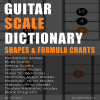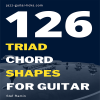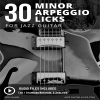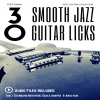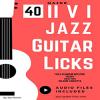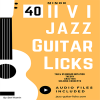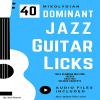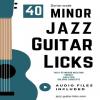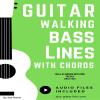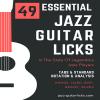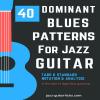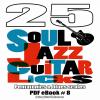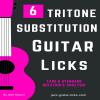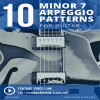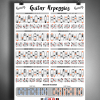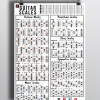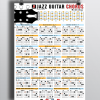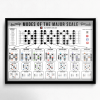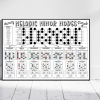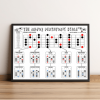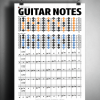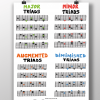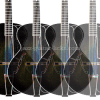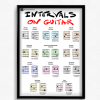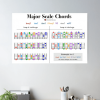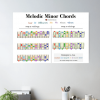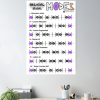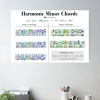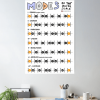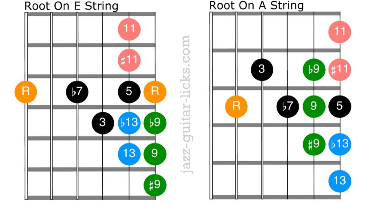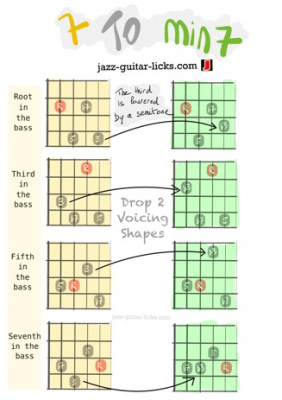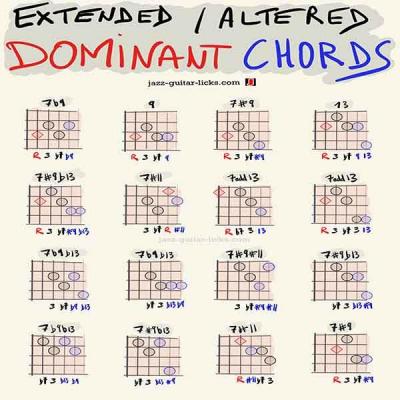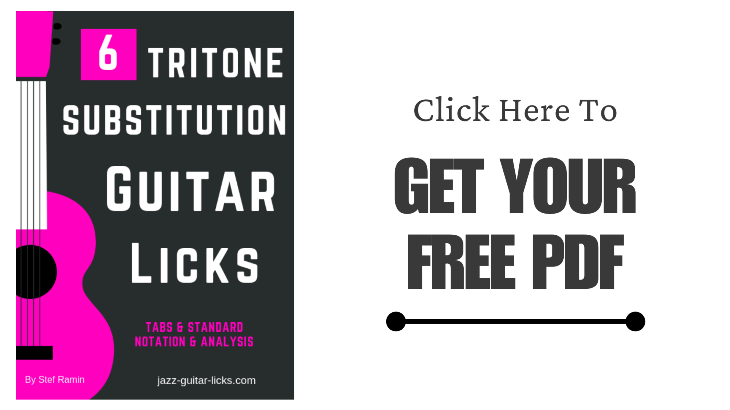
What Are Dominant Seventh Chords ?
- By jazz-guitar-licks
- On 2018-09-29
- 0 comments
Dominant seventh chords are the most important features in music, you can find them in many styles of music, especially in blues and, of course, in jazz. In this lesson, you will see how to construct drop 2, drop 3 and drop 2 & 4 dominant seventh chords, what is their harmonic function and how to play them on guitar.
Dominant 7 Chord Construction
A Dominant 7 chord is built from the 5th degree of a scale, which is the dominant degree. Let's take the C major scale as an example, the tetrad chord (four notes) built from the 5th degree is G7.
You can see a dominant 7 chord as a major triad with an added flattened seventh. This means that a dominant 7 chord is built with root (1), major third (3), perfect fifth (5) and minor seventh (b7).
| Formula | 1 | 3 | 5 | b7 |
| G dominant 7th chord (G7) | G | B | D | F |
Chord Symbol
Dominant 7 chords are written with a "7" after the name of the chord. Exemple with C7 = C dominant 7. The roman numeral V is used to indicate a chord built from the fifth degree of a scale. In that way, "V7" is being used when referencing the dominant seventh chord.
Difference Between Major 7 Chords
Dominant 7 chords must not be confused with major 7 chords which are built with root (1), major third (3), perfect fifth (5) and major seventh (7). Indeed, the only one difference is in the seventh.
Harmonic Function
Harmonic function defines the relationship between chords of a given key. Dominant chord produces instability and tension which tends to resolve to the tonic chord (I). Let's take G7 (G-B-D-F) the degree V of the C major scale.
The third (B) and the minor seventh (F) of G7 form an interval of 6 semi-tones called "tritone". This is an unstable and dissonnant interval that produce a strong tension. This tension makes the unstable notes want to move to their nearest neighbour note. Example with the C major scale :
- F, The b7 of G7 wants to resolve to the E the third of C (red arrow).
- B, The 3 third of G7 wants to resolve to the I of C that is obviously C (blue arrow).

In a chord progression, a dominant 7 chord is generally used for the V chord leading to the I chord. For example, you can get V7 – Imaj7 (major key) or V7 – im7 (minor key).
C Major Scale Chart
- The degree as a roman numeral.
- The name of the mode.
- The name of the scale degree.
- The interval of each step (T=tone, S=semitone)
| Degree | Mode | Degree Name (harmonic function) | Intervals |
| I | Ionian | Tonic | TTsTTTs |
| II | Dorian | Supertonic | TsTTTsT |
| III | Phrygian | Mediant | sTTTsTT |
| IV | Lydian | Subdominant | TTTsTTs |
| V | Mixolydian | Dominant | TTsTTsT |
| VI | Aeolian | Submediant | TsTTsTT |
| VII | Locrian | Subtonic | sTTsTTT |
Dominant 7 Basic Positions
Let's start with dominant 7 chords in “open positions”. Open chords are chords that include one or more unfretted strings. They are generally learned first by guitar beginners. The eight diagrams below represent the most basic guitar positions.
You will find on the right, a YouTube jazz backing track for practicing dominant 7 arpeggios, scales and chords.
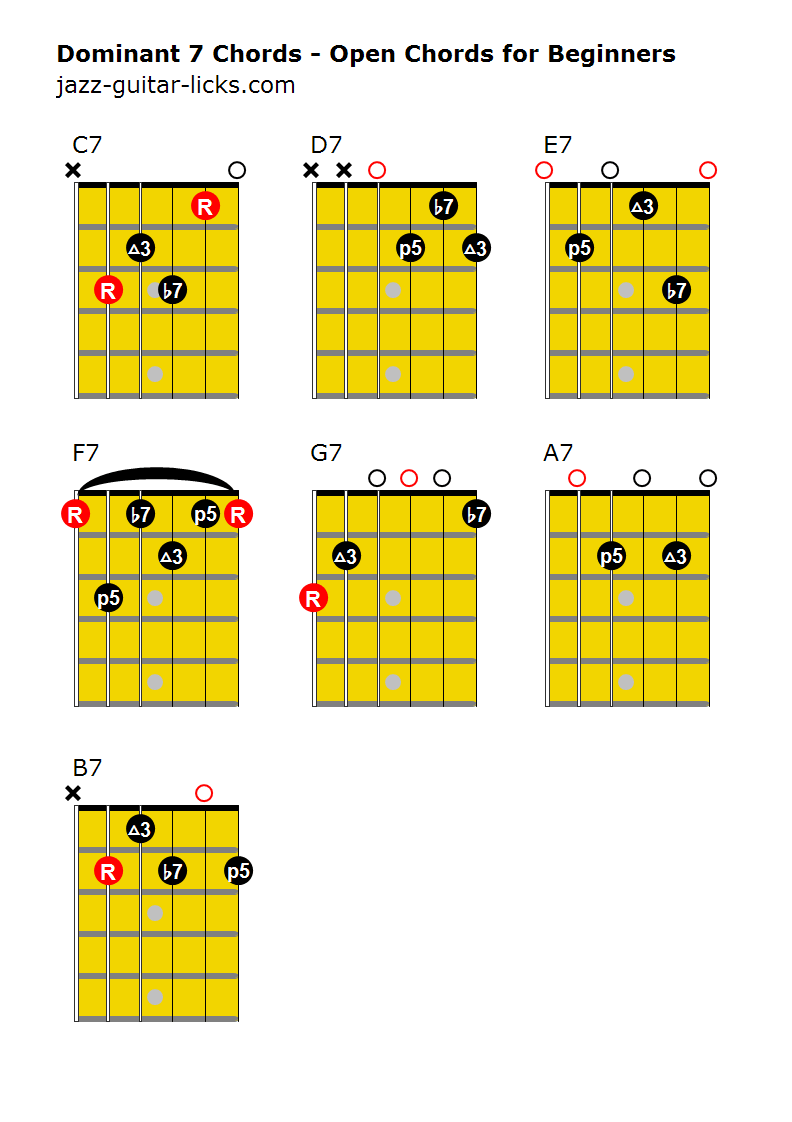
Drop 2 Voicings
Drop 2 Voicings are one of the most used chords in jazz because in comparison with drop 3 and drop 2-4 chords, they are less stretchy and more easy to play. Drop 2 chords are built by dropping the second highest voice of a chord down to the bottom.
Dominant 7 drop 2 voicing in its root position is R - 5 - b7 - 3. This implies three inversions that are :
- 3 - b7 - R - 5 (1st inversion)
- 5 - R - 3 - b7 (2nd inversion)
- b7 - 3 - 5 - R (3rd inversion)

Drop 2 dominant 7 chords - Basses on fourth string

Drop 2 dominant 7 chords - Basses on fifth string

Drop 2 dominant 7 chords - Basses on sixth string
Drop 3 Voicings
Drop 3 chords are built by dropping the third highest note of a close voicing. They are greatly appreciated by guitarists for comping and soloing. They can be very useful in music composition and arrangement. The particularity of drop 3 voicings is that the bass notes are on the fifth and sixth string and there is a string skip between the two lowest notes.
Dominant 7 drop 3 root voicing is R - b7 - 3 - 5. The inverted voicings are :
- 3 - R - 5 - b7 (1st inversion)
- 5 - 3 - b7 - R (2nd inversion)
- b7 - 5 - R - 3 (3rd inversion)

Drop 3 dominant 7 chords - Basses on sixth string

Drop 3 dominant 7 chords - Basses on fifth string
Drop 2 & 4 Voicings
Drop 2 & 4 chords are constructed by dropping down to the octave the second and the fourth note of a chord in close position. They are not the most used by guitar players, but, they can be interesting for composition and arrangement.
Dominant 7 drop 2-4 root voicing is R - 5 - 3 - b7. The inversions are :
- 3 - b7 - 5 - R (1st inversion)
- 5 - R - b7 - 3 (2nd inversion)
- b7 - 3 - R - 5 (3rd inversion)

Drop 2 & 4 dominant 7 chords - Basses on fifth string

Drop 2 & 4 dominant 7 chords - Basses on sixth string
-
Guitar Chord Dictionary
This PDF eBook provides over 550 guitar chord shapes. This is the perfect reference guide to understand how chords are built and how to play them on the guitar neck. -
Guitar Scale Dictionary
This E-book is a printable PDF method including over 700 scale diagrams and formula charts for guitarists. -
Harmonized Scales For Guitar
Complete guitar PDF on harmonized scales: major, minor, harmonic and melodic. Includes chord and arpeggio diagrams, charts and practical tabs. -
172 Arpeggio Shapes For Guitar
This printable PDF is a method dedicated to guitarists of all styles who want to learn build and play the most important types of arpeggios. -
126 Triad Chord Shapes
This handbook for guitar players is intended both for teachers and students. It includes 126 guitar shapes for mastering triads. -
Harmonic Major Scale Chords
this PDF offers diagrams and tabs for guitar to learn the chords of the harmonic major scale. -
Major Scale Harmonization
This package provides a printable PDF with exercises and audio files to learn how to harmonize the major scale with 3 note chords and their extensions. -
30 Minor Arpeggio Licks
This package includes a printable PDF method containing 30 exercises with tabs, staves and audio files for practicing minor arpeggios on guitar. -
II V I Bundle - 170 Exercises
This bundle contains 4 PDF methods for a total of 170 exercises with tabs, staves, analysis & audio files for practicing scales, arpeggios licks & chords over the 2-5-1 progression. -
Diatonic Licks Bundle
This package contains 120 jazz guitar lines based on diatonic modes as Mixolydian, Dorian and Ionian. PDF format with tabs, audio files and analysis. -
30 Groovy Jazz Guitar Licks
This downloadable package contains a PDF WITH audio files giving access to 30 groovy guitar phrases mixing jazz, blues and funky licks for beginners. -
30 Smooth Jazz Guitar Licks
In this package you'll get a printable PDF Method with tabs, notation, analysis, scale shapes and audio files for practicing 30 smooth jazz guitar licks. -
40 II V I Jazz Guitar Licks
This pdf method for guitar contains fourteen 2 5 1 jazz guitar lines with tab, standard notation, analysis, scale charts and audio files. -
50 II-V-I voicings
This printable PDF guitar method provides 50 exercises with audio files, analysis, tab and staves for learning major 2-5-1 chord voicings. -
40 Minor 2 5 1 Chord Voicings
This PDF method contains 40 exercices with tabs, scores and audio files for practicing jazz guitar chords over the minor 2 5 1 progression. -
40 Minor II V I Licks
This guitar method is a printable PDF with tabs, diagrams, theory and audio files providing 40 minor 2 5 1 jazz patterns. -
40 Mixolydian Jazz Guitar Lick
PDF guitar method with tabs, audio files and theory providing 40 dominant jazz guitar lines for teachers and students. -
40 Minor Jazz Guitar Licks
This printable guitar method in PDF format contains 40 easy minor jazz guitar lines based on the Dorian mode. -
40 Major Jazz Guitar Licks
Printable PDF eBook method containing 40 major jazz guitar licks with tab, standard notation and audio files for beginners and intermediates. -
Guitar Walking Bass Lines
This jazz guitar method about walking bass lines and chords is available as a PDF files containing 35 exercises with tabs, analysis and audio files -
101 Dominant Arpeggio Patterns
This printable PDF method provides 101 dominant arpeggio exercises with tab, theory and standard notation for the jazz, blues and rock guitarist. -
49 Essential Jazz Lines
This printable eBook method in PDF format provides 49 jazz solo transcriptions of the greatest jazz musicians. Tab, standard notation, audio files & analysis. -
11 Jazz Blues Studies
11 jazz blues chord studies with tabs, standard notation, analysis, and audio recordings and PDF. -
10 Easy Fingerstyle Blues
This PDF with Tabs and audio files provides 10 easy acoustic fingerstyle blues guitar studies for kids and beginners. -
25 Altered Jazz Guitar Lines
This PDF eBook method contains 25 altered jazz guitar licks with tabs, patterns, scale charts and audio files to master, apply and develop the altered scale. -
40 Blues Dominant Patterns
This printable method is available as a PDF file containing 40 easy dominant jazz-blues guitar lines with tabs, standard notation, analysis, audio files and scale charts. -
25 Pentatonic Licks
This jazz guitar method is an eBook available as a PDF with standard notation, guitar tabs, diagrams, analysis, audio files and backing tracks. You will find in this booklet 25 easy jazz guitar lines with theory using common and rare pentatonic scales. -
25 Soul Jazz Guitar Licks
You will find here an eBook available in PDF containing 25 soul jazz and hard bop guitar licks in the style of Grant Green, Melvin Sparks, George Benson. -
25 Diminished Patterns
This eBook PDF with audio files contains 25 dominant diminished jazz guitar patterns using the half-whole diminished scale and diminished 7th arpeggios. -
6 Tritone substitution licks
This Printable PDF eBook available for free download contains 6 easy jazz guitar licks with tabs/notation, youtube video link and analysis about the tritone substitution. -
10 Minor 7 Arpeggio Patterns
This printable PDF eBook offers 10 easy minor 7 arpeggio patterns with its related YouTube video for beginner guitarists. -
10 Easy Major 7 Arpeggio Licks
This is a printable PDF for beginner jazz guitar players providing 10 easy licks to practice major 7 arpeggios. -
10 Chord Melody Lines
Within this package, you'll discover a set of ten chord melody exercises for beginners. Printable PDFaudio files, a backing track, and a link to the associated YouTube video. -
10 Minor Blues Scale Licks
You'll find here a PDF with 10 easy jazz guitar licks to practice the minor blues scale on guitar.
-
Guitar Arpeggios Poster
This giant guitar poster for any guitar player, student or instructor contains colorful arpeggio diagrams. Giant size 24 x 36 inches (60 x 90 cm). -
Guitar Scales Poster 24*36
Guitar posters and wall art with eighteen neck diagrams representing the most used scales in music. -
Guitar Chord Poster
This printed color posters contains 63 guitar chord diagrams for jazz players, students, teachers and schools. -
Guitar Modes Poster
Guitar reference posters and wall art about modes of the major scale for guitar teachers, students and music schools. -
Melodic Minor Modes Poster
Educative and decorative giant guitar poster with neck diagrams, interval names about the seven modes of the melodic minor scale. -
Pentatonic Scale Guitar Poster
This guitar reference poster shows the positions and intervals of the major pentatonic scale. -
Guitar Notes Poster
This is a giant poster showing the notes on the guitar fret board and their positions on a musical staff. -
Triads Guitar Poster
This reference poster show the positions and intervals of the main triads used on guitar. This is a useful tool for guitarists, teacher and students. -
Four Archtop Guitars Poster
This is a decorative poster with four archtop jazz guitars. Several size and colors in landscape format available on Teespring and redbubble. -
Intervals On Guitar - Poster
This giant poster for guitar provides neck diagrams with interval positions. -
Melodic Minor Modes
This music theory poster available in several sizes shows the construction of the seven modes of the melodic minor scale. -
Major Scale Chords
This handy poster provides a clear visual guide to the chords built from the major scale, helping you recognize patterns and improve your playing. -
Melodic Minor Chords
Explore the rich harmonic possibilities of the melodic minor scale with this essential guitar poster. -
Harmonic Minor Modes
This music theory poster, offered in various sizes, demonstrates the structure of the seven modes of the melodic minor scale. -
Harmonic Minor Chords
Discover the chords of the harmonic minor scale with this guitar poster. -
Major Scale Modes
This poster is created for music teachers and students, illustrating the structure of the seven modes of the major scale.
dominant 7 chords seventh chords dominant chords drop 2-4 drop 3 drop 2 Theory harmony voicings chords
Add a comment





